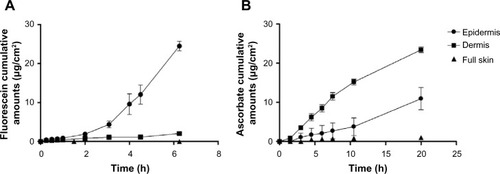Figures & data
Table 1 Physical characteristics of liposomes: z-average mean size (d), polydispersity index (PI), zeta potential (ζ), and encapsulation efficiency (E%) for sodium ascorbate
Figure 1 Human skin penetration of empty phosphatidylcholine liposomes.
Abbreviation: h, hours.

Figure 2 Fluorescein liposome penetration in whole skin.
Abbreviations: min, minutes; h, hours.

Figure 3 Comparative skin penetration of fluorescein and ascorbate liposomes in different human skin layers.
Abbreviation: h, hours.

Table 2 Permeability coefficients (Kp) for all formulation tested
Figure 4 Antioxidant and anti-inflammatory capacity of ascorbate liposomes in human skin irradiated by ultraviolet (UV)A/UVB.

